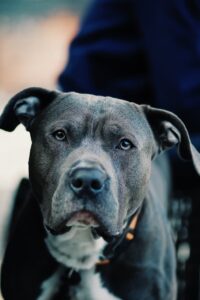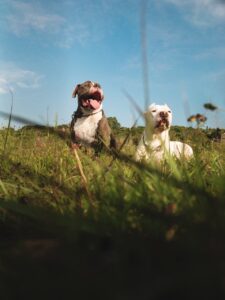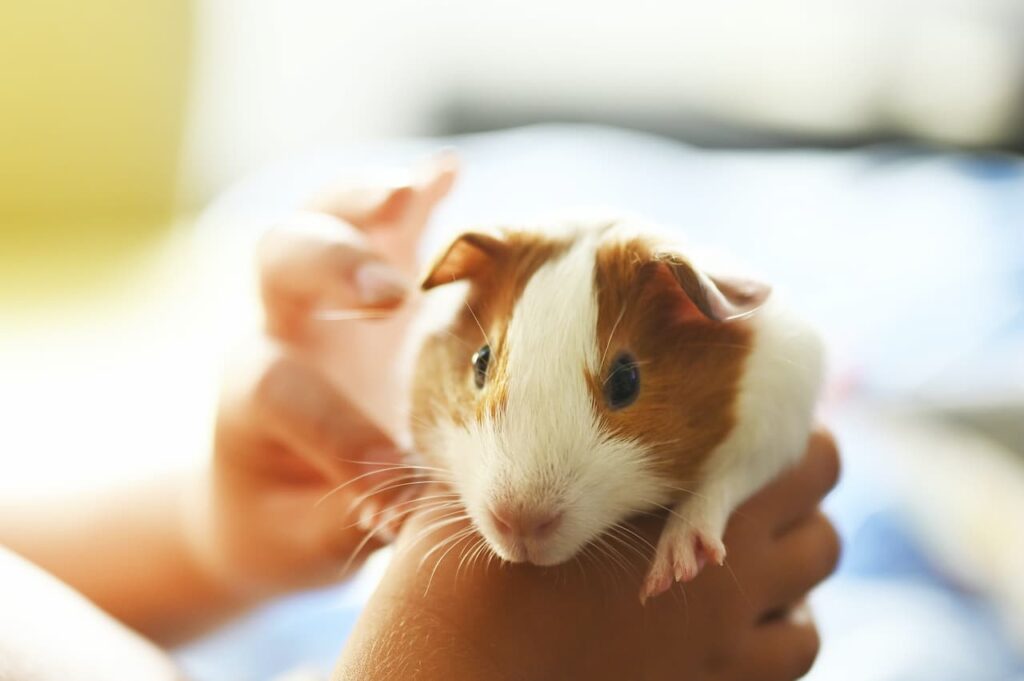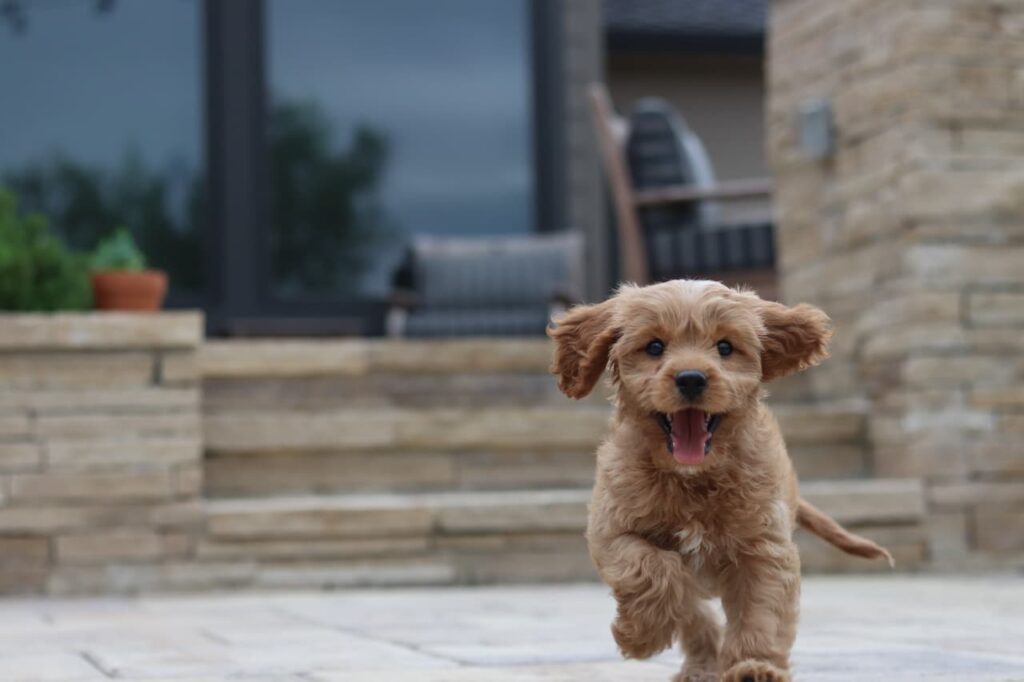The Ultimate Blue Nose Pitbull Guide
Thanks to unfair portrayals in media and pop-culture, Pit Bull Terriers have gotten a bad reputation. Many people mistakenly believe them to be unpredictably violent and vicious, basing their opinion on biased misrepresentations.
Table of Contents
ToggleIn reality, however, the vast majority of Pit Bulls are nothing like the stereotype.
The breed has been around a long time, since at least the 19th century, and while the breed itself is well established and AKC recognized, the subcategory of Blue Nose Pitbull has not been officially recognized as a separate breed.
recognized as a separate breed.
The blue nose is a relatively rare manifestation of a recessive gene, and typically accompanies a blue or blue fawn coat and even blue or grey eyes, making the Blue Nose Pitbull a strikingly handsome dog.
AKC standards regarding the appearance of the Pit Bull Terrier allow for more variety than is permitted with other breeds, but regardless of color pattern, the Pit Bull Terrier should be sturdy, strong, and lean, not overly blocky or bulky, and the Blue Nose Pitbull is no exception.
They are sturdy dogs, with large heads and deep chests, and often have a proud and regal bearing despite their energetic, playful attitudes.
Want to learn more about other breeds? Check out the loveable Cavapoo.
Behavior
The Blue Nose Pitbull is a terrier, and like all terriers, was bred to hunt small game and kill vermin.
Therefore you must socialize your Blue Nose Pitbull Terrier from an early age with other dogs and animals to avoid animal aggression.
This natural prey drive was later exploited when the breed was cruelly used for such blood sports as bull-baiting and dog fighting, but despite popular belief, neither of these were the original intended purpose of the Pit Bull.
A strong prey drive does not necessarily mean a well socialized Blue Nose Pitbull can never have healthy interactions with other animals.
There are many cases of Pit Bulls living happily alongside other dogs and other species, but each dog is an individual, so keep in mind that even with proper exposure to other animals, yours may not do well with cats or other pets.
Another trait the Blue Nose Pitbull Terrier shares with other terriers is a very high energy level.
Pit Bulls require a lot of exercises, so if you don’t like physical activity, this is probably not the dog for you. Moderate, leisurely are probably not going to cut it with this breed.
Your Blue Nose Pitbull is going to need, at the very least, an hour of reasonably vigorous exercise each day, and may even require more than that.
Running and hiking are great options to help your Pit Bull burn off some of their reserves of excess energy.
If you feel like your pet still needs to let off some steam, consider adding a doggy backpack to your routine.
Although the Blue Nose Pit Bull is strong, you should not add heavyweights to the pack, as this can lead to back pain or orthopedic injury, but you can add something reasonably lightweight and manageable, like a small water bottle on each side, so that the load is balanced.
By adding a little extra bulk, your dog will have to exert himself or herself a little more, which is excellent for a breed like the Pit Bull.
Being a responsible Pit Bull owner means using the appropriate leash.
A harness is not a suitable implement to be used when walking a Pit Bull unless directed by a veterinarian as a result of injury to the cervical spine or other medical prohibitions on a neck lead.
Pit Bulls have a low center of gravity and drive themselves with their thoracic limbs, i.e., the front legs, so his or her chest is a powerhouse.
Using a harness on a Pit Bull body type gives the handler very little control. Extendable leashes are also inappropriate for this, and most other large breeds and using one can result in injury to pet or owner.
A standard six- foot nylon lead is ideal for your Blue Nose Pit Bull and will allow you both to enjoy safe, outdoor physical activity.
Inadequate exercise can have unpleasant consequences with this breed, leading to boredom, anxiety, and destructive behaviors.
Appropriate outlets for their energy are essential.
Aggression Myths
Despite the pop-culture representation of the “aggressive” Pit Bull, they are not bred or intended to show aggression towards humans, and they usually won’t unless poorly socialized or treated harshly.
Human aggression is discouraged per AKC breed standard, and responsible breeders who respect the breed do not continue the bloodline of dogs displaying human aggression.
Your Blue Nose Pit Bull is more likely to be enthusiastic, outgoing, and friendly with people.
Pit Bulls, as a rule, are loyal. They can make great family companions and have been proving this fact for more than a hundred years.
Before the breed was branded with the “mean and tough” image and adopted as a macho status symbol, they were recognized as a family pet and even given the nickname “the nanny dog” because they were gentle and affectionate with kids and made great guardians.
Pit Bulls are intelligent and curious, and many Blue Nose Pit Bull owners report that their pet is clownish and even seems to have a sense of humor.
While they can be quite stubborn, they are highly trainable and eager to please. Because many of them are very food motivated, using small treats as a reward during the early stages of training may yield better results, but be aware of calorie content.
Use a piece of kibble or a small portion of a treat as a reward instead of the whole thing.
Giving the entire gift each time your pet successfully executes a command during a training session can result in excess body fat and obesity.
Grooming
The Blue Nose Pit Bull is easy to groom and will not require professional services, as long as you are willing to bathe him or her at home, which shouldn’t take long, as they suds up easily and dry quickly.
Their fur is short and smooth, requiring minimal brushing and making it easy to do a quick wipe down with a wet cloth to help keep your pet clean.
Pit Bulls do shed, but they do not have an undercoat or “blow” their coat seasonally, so you will probably notice less shedding with this breed than a long-haired dog.
Use of a de-shedding brush is a fast and effective way to minimize shedding and keep your dog looking good.
Health
While the Blue Nose Pit Bull is a sturdy breed and relatively healthy when compared with other purebred dogs, there are a few health concerns to be aware of.
Skin conditions are relatively common with this breed. Contact allergies, dry skin, and rashes or hives occur in this breed, and although not life-threatening, they can be uncomfortable and unsightly.
Specific orthopedic issues arise with Pit Bulls as well, and they can be prone to congenital hip dysplasia, a condition resulting from the failure of the femoral head (ball at the top of the thigh bone) to fit appropriately into the acetabulum (a concave portion of the pelvis.)
This failure to accurately articulate can lead to pain and reduced range of motion and, if severe, may require surgical intervention.
You should make sure that both the sire (male parent) and dam (female parent) of your prospective puppy have had their hips x-rayed, and the x-rays have been evaluated and received a grade of “good” or higher from the OFA (Orthopedic Foundation for Animals).
Common Injuries
A common orthopedic injury in Pit Bull Terriers is a ruptured ACL or Anterior Cruciate Ligament.
This occurs when a ligament in the kneecap is severed, and normal joint function is impaired, and occurs most frequently in active, large breed dogs and requires surgical correction.
ACL surgery is neither cheap nor pleasant, so you may want to consider looking into pet insurance. If you choose not to utilize a pet insurance policy, set some money aside, just in case.
Making sure your Blue Nose Pit Bull does not become overweight is one way to reduce the risk of ACL injury.
A concern with Pit Bulls and other large breeds is Gastric Torsion, AKA “bloat” or GDV (Gastric Dilation and Volvulus.)
This is a severe, life-threatening condition that requires immediate medical attention. GDV happens when the stomach “flips” or “twists” (torsion), resulting in a dangerous and extremely painful backup of gas and other material that is prevented from usually passing through the digestive tract.
I will discuss a few suggestions for reducing your pet’s risk of bloat later in this article.
Diet
Your Blue Nose Pit Bull should be fed a high-quality kibble in a measured quantity twice daily. Avoid store brands or generic “off” brands, which can be higher in fat and unhealthy preservatives and lower in protein and essential nutrients.
Feeding your Blue Nose Pit Bull once daily is not recommended, and studies show that doing so may increase their risk of developing bloat.
Separating your dog’s daily quantity of food into at least two servings, fed morning and night, is believed to be one way of reducing your large breed dog’s odds of developing this dangerous condition.
It is also essential that you time your dog’s feeding so that they do not coincide with his or her daily exercise.
If you plan to feed your Pit Bull after a morning walk, you should wait until he or she is no longer panting or showing signs of exertion, and respirations have returned to normal before doing so.
Do not allow your Pit Bull to engage in exercise for at least two hours after eating. The activity must be limited after feeding.
Symptoms of bloat include pain, tense or distended abdomen, weakness, lethargy, and vomiting. If you observe these symptoms, consider it an emergency and contact a veterinarian immediately.
Just because your Blue Nose Pit Bull looks tough doesn’t mean his digestive tract is.
Avoid fattening foods, table scraps, bones, and/or rawhide chews, all of which have the potential to cause gastrointestinal upset and can lead to intestinal obstructions, especially bones and rawhides.
Breeders and groomers will occasionally recommend a “raw” diet or one that is grain-free. Advice about your dog’s health should come from his or her veterinarian.
Raw foods will never be medically recommended, and if your pet requires a limited ingredient diet, only a medical professional is qualified to decide which diet is suitable.
You wouldn’t take medical advice from your hairstylist. Extend the same common sense courtesy to your dog.
If you are looking for a smaller and different type of dog, read our Teacup Poodle Guide.
Toys
Resilient, sturdy toys are a necessity with a Blue Nose Pitbull.
The myth that they have a “locking jaw” is false and ridiculous, but they do have a powerful jaw capable of reducing flimsy toys to bits and pieces in the blink of an eye.
Like most terriers, Pit Bulls love to play and enjoy chewing, but you must provide him or her with chew toys that are appropriate for heavy chewers and will not be easily broken down into pieces that are small enough for him or her to consume.
There are toys designed specifically for “bully breeds,” and these tend to stand up well to wear and tear.
If you decide to make a Blue Nose Pit Bull part of your family, be a responsible owner.
Fight the stereotype.
Educate yourself. Be an ambassador for the breed and show the world how awesome they can be!


